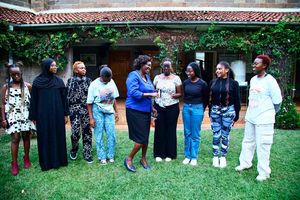Gomesi: Uganda's dress that's a symbol of respect and dignity

Ugandan women dressed in different colourful gomesi dresses in Namasuba, Kampala.
Elegance and colour are simply the description of Buganda Kingdom's traditional garment, the gomesi or bodingi. No traditional function in central Uganda and many other parts of the country is complete without women immaculately dressed in the gomesi — the fabulous floor-length brightly coloured dress with a square neckline and short puffed sleeves.
The traditional marriage ceremony is one such function where the gomesi is a must.
Dressing up in a gomesi is tedious and time consuming because of the different pieces of cloth that accompany it. Before the gomesi, you need to wear a kikooyi, the thick cotton fabric worn underneath.
The kikooyi is wrapped around the body several times. It is tied with a string or belt around the waist to ensure it is firm.
“A kikooyi is worn underneath the gomesi to give it shape, and is worn with a three to four metres sash (ekitambala) made from slightly heavier embellished fabric tied around the waist with a ‘square knot’ to hold the flowing outfit firmly together,” Angela Luyiga writes in her article History of the Gomesi-Busuuti.
Matching colours
According to a seamstress, Justine Muyingo, the sash has to match with the colour of the dress. The gomesi has two buttons on the left side of the neckline. The buttons match with the colour of the cloth and necklace. The embroidery (mudalizo) that is sewed at the edge or hem of the gomesi keeps it very beautiful.
Muyingo told The East African that the gomesi is a mark of respect and dignity.
''It is honoured very much in Buganda as a traditional dress. When you wear it, you are honoured.”
“I wear it for special occasions like weddings and church. I also dress in a gomesi when I am giving lessons as a trainer and counsellor,” says Muyingo, a teacher and counsellor of young couples.

Buganda Kabaka Muwenda Mutebi II dressed in traditional regalia and Sylvia Nagginda the queen of Buganda in a gomesi.
Gomesi for all occasions
Harriet Nakalema, a fruit vendor in Wabigalo, a Kampala suburb, says she wears the gomesi for all occasions.
“It is the easiest and decent dress to wear for all occasions at home, including carrying a baby on your back. For me the gomesi gives me peace in all weather conditions,” Nakalema says.
Muyingo, who ran a shop in Kampala, dealing in women and children’s dresses in 1970s and 80s, says a gomesi can consume five to six metres of cloth, and can be made from all forms of fabrics, including cotton, silk, satin, linen, and sari.
“An ordinary gomesi made from cotton is sold for USh50,000 ($13.3). The price for a gomesi made from a good quality fabric, especially silk and linen ranges between Ushs150,000 ($40) and Ushs500,000 ($133),” she says.
According to Justine, expensive and durable fabrics are imported from England and the US. Other fabrics are also imported from India, Pakistan and Dubai.
“Linen and cotton are very rare fabrics. It is polyester that is popular among our customers,” the marketing and sales officer at Chrisms Designs in Kampala,” Irene Adoko told The East African.
“Most of our customers bring their fabrics for stitching” she adds.
Best material for gomesi
Polyester is best material for a gomesi because there is no need for ironing like other fabrics such as linen. The other advantage is that polyester will freely flow on your body, according to Nakalema.
The dot.com gomesi and new style gomesi were developed by Chrisms Designs Limited.
Adoko says cotton and linen do not flow so well like polyester because of its texture.
“Linen is more expensive because it has some unique features, especially in portraying African cultural patterns,” she says
According to Adoko, the new style gomesi is more of the usual dress with a lining inside.
“We make the kikooyi in form of a skirt; it is not so big and bulky. The foldings are simplified and held together to make it easy for one wearing the gomesi which is held by a sash. The sash on the new style gomesi is modern with matching buttons sewed on it unlike the traditional sash that has to be folded together.”
“The disadvantage with the modern sash is that when you gain or lose weight it has to be adjusted accordingly. When you dress up in a new style gomesi someone can’t tell that you are not putting on the traditional gomesi,” Adoko says.
Like a dress
According to Adoko, the dot.com gomesi is also like a dress, but its foldings are attached to the gomesi.
“You can put on a skirt or kikooyi under the dot.com gomesi. However, when you put on a dot.com gomesi one can easily tell that you are not wearing the traditional gomesi because the zip is visible on the top unlike the new style gomesi where the zip is hidden inside the dress.”
“The young women prefer the dot.com gomesi while the older women prefer the new style gomesi. This is because of the tediousness that comes with dressing up in the traditional gomesi,” says Adoko.
Back to original design
Justine is not in favour of the new gomesi designs, arguing: “Many people have tried to modify the gomesi but they have failed because they want light dresses. They end up going back to the original design and structure of the gomesi.”
Sarah Nakisanze, a fashion designer based in Kampala, says the evolution that maintains traditional cultural design identity features enables the continuity of/preserves tradition for the present and future.
“Over the years, major features of the gomesi such as the shoulder high puffed sleeve, square neckline, button fasteners and sash have had dimension adaptations. There is also embrace of new fabrics and fabric decorations that come with innovation and creativity in application. The design of the gomesi is resilient. I would like to believe that this is intended by the designers; the need to preserve tradition and to earn from it,” Nakisanze, said.
However, there are conservatives from the Buganda who are resisting the modification of the traditional gomesi.
Nakisanze said: “They are unaware of the value embodied in tradition evolution. If society does not change the design for the young people to adopt it, they will dump it.”
Adoko says designers get a lot of orders from customers during holiday seasons like Christmas and Easter, and from large groups, especially church choirs.
Here to stay
Nakisanze, who is also a lecturer of fashion design and research at the Margaret Trowel School of Fine and Industrial Art, Makerere University, says the gomesi is here to stay, despite the simple trend adaptations and changes.
Asked why the gomesi has not been adopted by other countries like the kanga (garment) from Zanzibar, Nakisanze says the design has been locally adopted but has not attained the visibility required.
“The design is a Ugandan identity and markets Uganda and its people and not anyone else. It has featured at the global stage where Uganda is excelling, like in sports,” she says.
Origin of gomesi
The gomesi traces its origins to the pre-colonial era when women in Buganda wrapped themselves from the chest to ankle in a cloth called lubugo (bark-cloth) made from the bark of the Mutuba (Ficus natalensis) tree before the Arab traders and Christian missionaries arrived with cotton, which became the material of choice for garments.
In his article “The Origin of the Gomesi/Busuuti”, John H. R. Nazareth writes that there are conflicting historical records regarding the origins of the gomesi.
According to Nazareth, the story starts out with the birth of Gayaza High School in 1905 and Miss Alfreda Allen, the headmistress asking a tailor, Mr Gomes, to design a uniform for her girls.
“Reading through an article based on an interview with CM Gomes, he appeared to be unclear about whether it was he or his elder brother Anton Gloria Gomes (AG), both of whom were working together, who designed the dress,” Nazareth writes.
“So, the earliest that the Gomesi could have been designed was in 1905 when Gayaza High School opened. However, Gayaza first used the “suuka” made of bark-cloth as a school dress in 1905,” Nazareth adds.
“Between 1905 and 1908 Ms Allen approached AG Gomes to make a “suuka” of cotton as it was more durable. The next phase came to resolve the problem of the “suuka” unravelling when the students were doing manual work, so Miss Allen sought a better design to preserve the modesty of the pupils. AG did that by adding a yoke to the design,” Nazareth further adds.
Kabaka’s coronation
According to Nazareth, the gomesi did not become popular with the masses until the wife of Kabaka Daudi Chwa II wore it for the Kabaka’s coronation – and it was Gomes who had stitched her dress.
The gomesi has some aspects of Victorian/Edwardian dresses (those puffed sleeves) and some aspects of the sari that Gomes was familiar with from his homeland – Goa in India. A sash was also added around the waist to accentuate the feminine figure.
“Kabaka Chwa’s coronation took place in 1914 and hence it is this year that should be honoured as the birth-year of the Gomesi/Busuuti,” Nazareth says.
“Gomes improved the suuka by introducing the sleeves, kaba and ekitambala. The sleeve and kaba keeps somebody warm. He helped a lot because by improving the suuka many people use the gomesi today,” Muyingo said.
The original gomesi had sleeves that were not pointed. Today, the sleeves are longer and more pointed. Even with the modifications, the gomesi retains the elegance and style of old.
According to Nazareth, the name Gomesi is associated with the name of its designer, Mr Gomes. The dress used to be called Teitei Gomesi – the Gomes dress (“teitei” being the Swahili word for dress or gown). Over time, people dropped “teitei” and Gomesi it was.
“The name “Bodingi” has also been used, a name that probably came from the fact that Gayaza was a boarding school. This name was more associated with the school uniform than the fully matured gomesi dress design, but it is still occasionally used,” Nazareth adds.
***
This article was first published in The EastAfrican.




